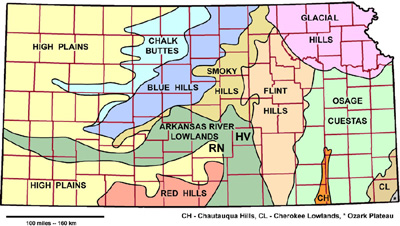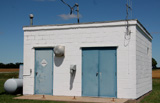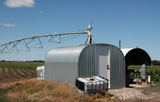James S. and Susan E.W. Aber |
| Introduction | Reno County |
| Harvey County | Battery storage |
| Summary | References |
The wide, open, largely treeless, agricultural landscape is attractive for development of wind farms in the mostly rural environment. The wind-energy potential is rated as fair with average wind speed at 50 m (160-foot) height of 15-17 mph—see wind speed. Many other wind farms in central and eastern Kansas operate under similar conditions. The following discussion is based mainly on news articles published in Harvey County Now and other sources listed in the references.
The wind farm was blocked by a grass-roots initiative in 2019. Those opposed to the wind farm had forced a protest petition that required unanimous approval by the Reno County Commission. When one commissioner voted no, the project was halted; the first wind farm to be rejected in Kansas during the previous decade.
NextEra Energy appealed this decision through a number of legal moves. Eventually the Kansas Court of Appeals upheld the protest petition and vote of the county commission to halt the wind farm. In the meantime, the Reno County Planning Commission had continued to review issues for potential wind turbines in unzoned portions of the county.
In a surprising move, the Reno County Commission approved wind-turbine zoning regulations in January 2022 that had been sent forward from the planning commission in December 2020. A new countywide overlay zone for wind farms will be applied to those areas not otherwise zoned. The key provision is a 2000-foot turbine setback from homes. Additional provisions deal with setbacks for roads, property lines, airports, and wildlife refuges. Shadow flicker and noise are also addressed in the approved regulations. The zoning requirements adopted by the Reno County Commission are much like those that NextEra Energy had agreed to follow.
The main point of contention was the requirement for turbine setback from property boundaries. Options discussed were setbacks of 2000, 1500, and 1000 feet. Another issue was potential disturbance or contamination of the Equus Beds Aquifer. In September 2022, the planning commission unanimously approved regulations that included a 1500-foot setback, noise level of 45 decibels measured at the edge of the property, and several other requirements. The matter then moved to the Harvey County Commission for further consideration.
The county commission held a public meeting and accepted comments. In October 2022, the county commission revised the regulations and approved setbacks of 1000 feet from property boundaries and 2000 feet from homes. Other provisions include protection of the Equus Beds Aquifer and financial obligations by NextEra Energy to pay for road maintenance.
NextEra Energy moved quickly in January 2023 to obtain conditional-use permits to erect four weather towers that stand 197 feet tall. These towers would monitor wind and weather conditions as a first phase to evaluate further development of a wind farm. Such towers are routine components of all wind farms.
Public opposition continued, nonetheless, and the county commission agreed in February 2023 to a six-month moratorium on wind turbines and to put the issue of wind energy to a public vote. On August 1, the county commission voted to extend the moratorium. The Planning and Zoning Committee recommended unanimously against commercial wind and solar developments. Finally the County Commissioners voted unanimously in November 2023 to prohibit commercial wind energy in the county. This ban includes all utility-scale wind-power and solar-energy systems. Protection of the Equus Beds Aquifer was a key issue for this decision.
Wind and solar energy production is inherently intermittent. The Tallgrass Prairie Energy Center would help to even out availability of electricity and prevent power outages. The proposed BESS would have a capacity of 200 MW and up to 800 MWh, which is enough electricity to power 200,000 homes for four hours. The initial lease-purchase agreement is good for two years during which further research and assessment would be conducted, and the facility could go online in 2027.
One concern with BESS is the risk of fire. Lithium-ion batteries are generally safe and are utilized in all types of devices from smart-phones to electric vehicles. But they have a known risk for fire and explosion when they are damaged or used improperly. Lithium-ion battery fires are especially dangerous, because water and fire extinguishers are not effective (FDNY 2024)
This problem was highlighted in 2019 by a fire and unexpected explosion at a BESS in Arizona, and FEMA has recognized this emerging problem. Fire incidents have happened also in California, Idaho, and New York as well as Australia, France, and other countries (EPRI 2024). In 2019 the National Fire Protection Association (NFPA) adopted Standard 855, which deals with the installation of stationary energy-storage systems, and Standard 855 was updated recently (NFPA 2023). Still, fires at battery-storage facilities remain rare, and improved standards and procedures should minimize this risk.
In January 2025, Halstead's Planning and Zoning Commission released its proposed BESS regulations after more than a year of investigations and public comments. The proposed regulations cover all aspects of construction, operation, safety, emergency procedures, and eventual decommissioning of the Tallgrass Prairie Energy Center. After a thorough review of the issues, the city Fire Chief noted that other industries already present in the city represent greater fire or explosion risks, and he was mostly comfortable with a BESS in the industrial park. As of July 2025, both Harvey County and the City of Halstead had approved temporary moratoriums for BESS until January 2028.
Text and images © J.S. and S.E.W. Aber.
Introduction
Reno and Harvey counties are located next to each other in south-central Kansas. Principal cities are Hutchinson in Reno County and Newton in Harvey County. The region is mostly the Arkansas River Lowlands and eastern margin of the High Plains and western edge of the Flint Hills. This is a broad and relatively flat terrain underlain by unconsolidated sand and gravel of the High Plains Aquifer. The portion in Harvey County is known as the Equus Beds Aquifer because of fossil horse teeth found in the sediment there.

Landscape regions of Kansas showing county boundaries marked in maroon. Reno County (RN) and Harvey County (HV). Adapted from Aber and Aber (2009). Reno County
NextEra Energy, a wind-farm development company, became interested in Reno County in the late 2010s in order to take advantage of federal tax credits that would expire in 2020. This set off public opposition based on many perceived environmental and health factors. Citizens were concerned about the conversion of rural aesthetic values for industrial development. Harvey County
As the drama in Reno County continued to play out, NextEra Energy began to explore the possibility for a wind farm in western Harvey County in the region between Halstead, Moundridge, and Burrton. Once again, public opposition came forward voicing many of the same objections heard in Reno County. The Harvey County Planning Commission held meetings with NextEra Energy and the public to consider these issues during 2022, and more than 200 people came to some of these meetings.Battery-storage facility
Halstead, in western Harvey County, announced plans in October 2023 with Concurrent, a Boston-based company, for a lease-purchase option to build a battery energy storage system, known as BESS, in Halstead Industrial Park. Lithium-ion batteries would store excess renewable wind and solar energy, then release the electricity when needed to Evergy transmission lines. The goal is to improve reliability of the Southwest Power Pool electric grid. The SPP includes most of the Great Plains states from North Dakota to Oklahoma as well as parts of adjacent states (SSP 2024). Summary
The issue of developing wind farms in Reno and Harvey counties has been contentious during the past several years. Numerous public meetings, committee reports, and debates have taken place. Harvey County has opted not to allow utility-scale wind or solar energy facilities; whereas, Reno County may allow future wind farms in certain portions of the county that meet several strict criteria. Halstead is under consideration for a BESS that would take in electricity generated elsewhere by wind and solar power. Thus, both counties may participate in green-energy development, but in different ways, and final decisions are still years away. References
![]()
All rights reserved.![]() Return to Kansas windscape.
Return to Kansas windscape.
Last update: July 2025.

